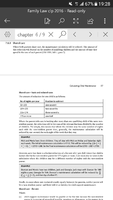Dear Colleagues,
Please click on the thumbnail / full image and look at Page 97 and the second grey box titled 'Example', where it says "Duncan's maintenance calculation will be reduced by
13/28 ( [7/14+ 6/14 ]) / 2 ) etc.
My question is : How did the calculation arrive at the fractions 7/14 + 6 / 14 ?.
Thank you

Please click on the thumbnail / full image and look at Page 97 and the second grey box titled 'Example', where it says "Duncan's maintenance calculation will be reduced by
13/28 ( [7/14+ 6/14 ]) / 2 ) etc.
My question is : How did the calculation arrive at the fractions 7/14 + 6 / 14 ?.
Thank you

